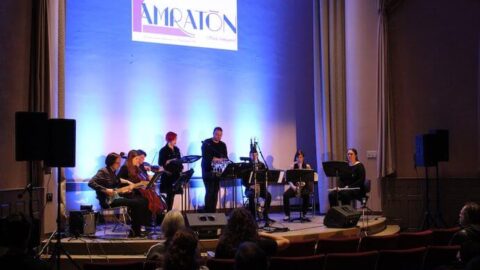From Friday, February 28 through Sunday, March 1, 2020, Pittsburgh played host to an unprecedented array of international performers, scholars and composers, all assembled in celebration of their special and unique passion for microtonal composition. Founded in 2015, Beyond 2020 Microtonal Music Festival marked the third such event presented by The University of Pittsburgh’s Music on the Edge contemporary music series, now in its 30th anniversary season. Beyond 2020 consumed the weekend with ticketed concerts, presentations of scholarly papers, marathon performances, and social gatherings.
Things kicked off with a Friday evening concert in the cavernous, black-box vault of Pittsburgh’s New Hazlett Theater. Opening with a somewhat lengthy sound-film collaboration entitled HANDS to MOUTHS by artist Mareike Yin-Yee and composer Marc Sabat, the program was divided into three parts and alternated between the Los Angeles-based sextet Brightwork and GRAMMY award-winning guitarist, composer, author, and broadcaster John Schneider. Bookended by Brightwork’s highly engaging performances of works by Pittsburgh-based composers Federico Garcia-De Castro, Amy Williams, Eric Moe, and Mathew Rosenblum, Schneider’s solo set was the highlight of the concert.
Schneider rotated primarily between two acoustic guitars specially adapted to microtonality, including the fretless “Partch Adapted Guitar II” and steel-bodied National Resophonic with an intricately customized fretboard. He performed several of his own compositions alongside those of Lou Harrison and Harry Partch. While these performances were infused with a moderately intellectual character, Schneider’s warm and inviting performances made short work of illustrating the unexpected familiarity of microtonality in even the most common forms of music. The use of a slide and metered recitation of haunting poetry conjured the essence of blues and folk as the complexity of the compositions ascended into an ethereal halo within the space.
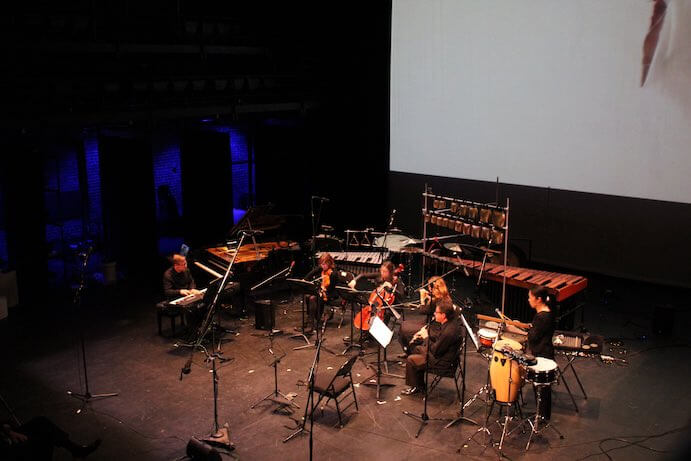
Brightwork returned with a theatrical rendition of Mathew Rosenblum’s 2013 work Falling. Based on a James Dickey poem of the same name, the piece imagines and chronicles the descent of an Allegheny Airlines flight attendant who was sucked out of the plane’s emergency exit and tragically fell to her death in October of 1962. Dancer Faith Jensen-Ismay played pantomime against the excellent vocalizations of Brightwork soprano Stacey Fraser, very effectively emphasizing the disturbing narrative against a soothing backdrop of clouds and landscapes prepared by lighting and projection designer Jason Mann.
Saturday started bright and early at 9:00AM with over three hours of presentations in the University of Pittsburgh’s Music Building. The first of two festival symposia, “Recent Scholarship on Microtonal Music,” covered topics from microtonal choral pedagogy to live demonstrations of the viola d’amore. Scholars and composers from as far off as Tucson, Arizona and Berlin, Germany included Taylor Brook, Robert Lopez-Hanshaw, Nicholas Stevens, Paul Miller, and Thomas Nicholson.
A tight time table and the laudable efficiency of each presenter kept the material appropriately accessible to the predominantly academic, sell-out crowd. Of particular note were Robert Lopez-Hanshaw’s pragmatic discussion of methods to teach the average American choir to effectively sing non-standard tuning systems, as well as Paul Miller’s comedic and engaging demonstration of the viola d’amore with the music of Klaus Huber (…Plainte…), Georg Friedrich Haas (Solo), and Aaron Cassidy (The Misprision of Transparency).
A two-hour gap made way for the afternoon’s epic marathon of local performers and ensembles within the Frick Fine Arts Building’s 200-seat, rococo auditorium. Despite a moderate delay caused by technical difficulties with the first piece on the program, “Concert II: Microtonal Pittsburgh” hurtled across nearly four hours of world premieres and vintage works at the hands of seven excellent ensembles comprised of nearly thirty performers.
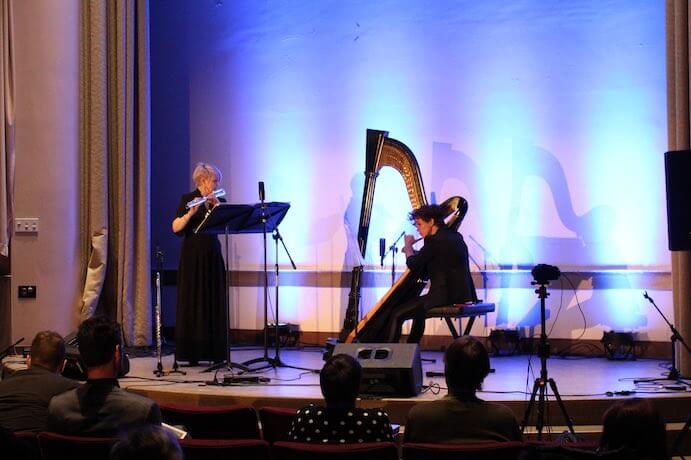
Nat28 opened with a fascinating work by Brian Riordan, which transformed the belly of the piano into a galactic, spectral void and evoked haunting sonorities reminiscent of Lachenmann and Iancu Dumitrescu. Cellist Ted Mook and violinist Pauline Kim Harris returned to the stage twice with various works by microtonal champion Ezra Sims, before flutist and new music champion Lindsey Goodman was joined by harpist Nuiko Wadden to resurrect the rarely-if-ever performed Ventilation Manual: A Dusk Ceremonial (1976) by the eminent Burr Van Nostrand. An endurance challenge for performer and listener alike, Van Nostrand’s enigmatic work celebrated the novelty of its time period impressively. Unfortunately, as the afternoon proceeded through ensembles Kamratōn and Alia Musica and compelling works by solo guitarist Aaron Myers-Brooks, attendance and attention continued to wane under the pressure of time, leaving only an intrepid few to hear the sparkling, textural organicism of new music noise-meisters WOLFTRAP.
If any part of Beyond 2020’s magnificent weekend of programming strayed too far into hazy territory, “Concert II” came the closest due to the sheer magnitude of its logistics. Those that managed to survive to the end likely emerged with more questions than answers regarding the expression of microtonality relative to the festival’s presumed mission. Particularly following the morning’s focused presentations on the scholarship underlying the movement, the density of the programming only clouded the question that had been suggested to that point: what qualifies a piece as microtonal? Is the implication of a category even necessary, or are we just emphasizing a particular facet present in all music that is at times more overt than others?
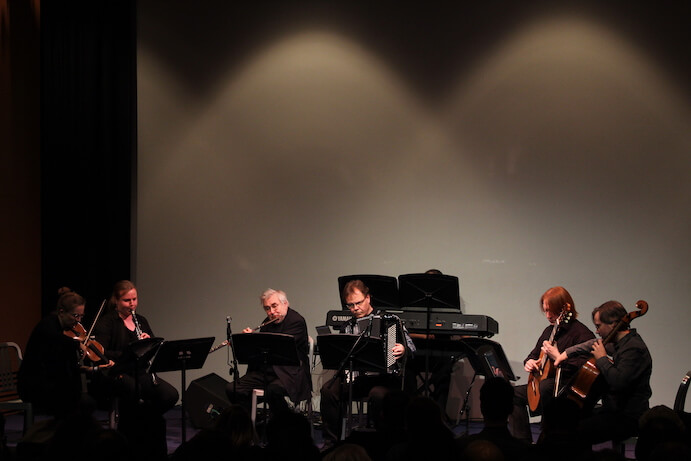
For “Concert III: Ray-Kallay Duo and MikroEnsemble,” disciples of the microtonal reconvened before the stage of the Andy Warhol Museum only hours after “Concert II” had concluded. Opening with a festive, retro composition by Tristan Murail for two DX7 synthesizers called Atlantys (1984), Los Angeles-based pianists Vicki Ray and Aron Kallay provided a focused and intelligent re-centering of the festival’s theme with a selection of fascinating pieces built upon innovative tuning systems. Sean Friar’s Fit (2020, East Coast Premiere) was unquestionably the highlight, roaring like a microtonal Hungarian Rhapsody for dueling re-tuned pianos.
Finnish chamber group MikroEnsemble followed, with an equally evocative program centered around their uniquely constructed instruments. These included the quarter-tone flute, quarter-tone guitar and a spectacular quarter-tone button accordion with which accordionist Veli Kujala premiered his own beautiful composition Mikrodancetudes.
The last day of the festival opened again at the Warhol Museum with the second and final pre-concert symposium followed by “Concert IV: FretX Guitar Duo and Del Sol String Quartet.” Keynote speaker John Schneider delivered a beautiful and concise overview of the history of the American microtonal movement, which flowed nicely into a group discussion of the music of Ben Johnston by the members of Del Sol. Johnny Reinhard, founder of the New York-based American Festival of Microtonal Music rounded out the conversation with a technical discussion of his approach to cognizing even the most minute pitch variation (a single cent), complete with examples intoned on a plastic recorder.
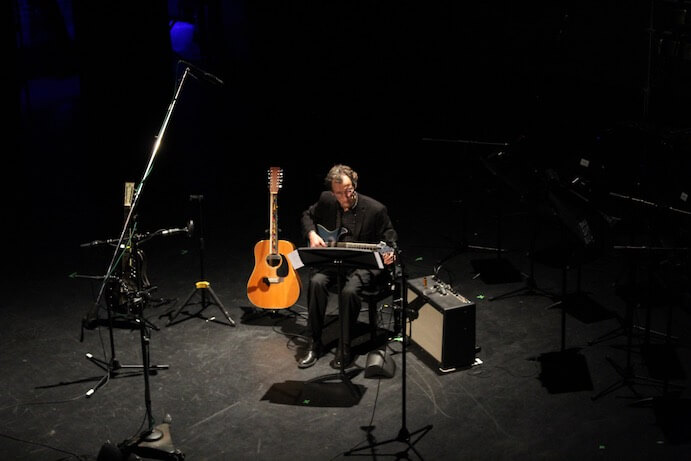
To say that Beyond 2020 saved the best for last may be a bit subjective, but it is hard to exaggerate the awe-inspiring excellence of both FretX and the Del Sol String Quartet. At the conclusion of such an enormously varied weekend of programming, these ensembles returned to a purity of form and intention that offered a neat summary of microtonal composition, both conceptually and in flawless execution. FretX’s rendition of Helmut Lachenmann’s Salut fur Caudwell was a triumph of expressive coordination, while Del Sol closed the evening with similarly prodigious musicianship coursing through works of Ben Johnston (String Quartet No. 10), Michael Harrison (Mureed), and Deqing Wen (Ink Splashing II). A beautiful video (projected with Harrison’s Mureed) created by Lenore Thomas and Ivette Spradlin deserves particular note; a classic Pittsburgh neighborhood overlaid with silhouettes of moving colors against real footage of undulating clouds gave the performance a subtle vibe of home-team spirit.
So, what does one conclude after such a densely packed weekend of boundary smashing performances, scholarship, and philosophy? To put it succinctly: microtonality does not exist. As the weekend’s events illustrated, the space in-between the notes is only measured in comparison to learned behaviors and accepted norms. The imperialistic perspective of the European piano keyboard is no different than our abbreviation of the visible spectrum of light with the seven colors of the rainbow. From this perspective Beyond 2020 becomes less about retreating into the secret clubhouse of the inaccessible or the avant-garde, and more of a high fidelity celebration of the mysterious depth and beauty that is potential in all music.
